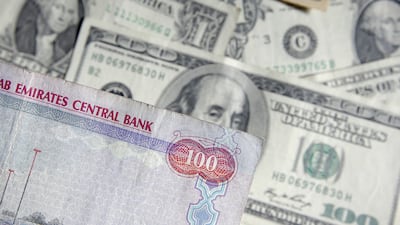This month, the UAE Central Bank followed the US Federal Reserve by cutting interest rates for a second time, following a reduction in September. The aim of the move is to further support the economy by boosting spending and lending. The UAE banking regulator had similarly followed the US central bank by raising rates from March 2022 to curb soaring inflation.
But why does the UAE’s monetary policy mirror that of the US? For that we go back 27 years to November 1997 when the UAE officially pegged its currency at 3.6725 dirhams to the US dollar. The dirham, established on May 19, 1973, almost two years after the UAE itself was founded, was reflective of the many emirates that came together under one flag.
A currency peg is aimed at stabilising the exchange rate between countries to support trade and reduce risk. Along with the UAE, most other Gulf countries, including Saudi Arabia, Bahrain, Qatar and Oman have also pegged their currencies to the US dollar.
“The UAE’s decision to peg the dirham to the US dollar in 1997 has brought clear benefits to the country, especially given its dependence on oil exports priced in dollars,” explains Damian Hitchen, chief executive of Asia Pacific and Middle East and North Africa at Saxo Bank.

The peg has enabled exchange rate stability, which is critical for mitigating commodity price volatility and ensuring steady revenue from exports, he says. “It has also fostered an environment of investor confidence and economic predictability, making the UAE a reliable destination for international investors. These benefits reassure us of the soundness of the peg.”
Despite the advantages, the peg means that when the dollar has faced pressure, it can also affect the UAE’s domestic monetary policy decisions.
Over the years, there have been several reports about the UAE looking at the possibility of moving its peg from the dollar to a basket of currencies, similar to Kuwait, to reduce risks. But the country’s Central Bank has reiterated that it remains confident about the dollar peg.
“The national economic indicators strongly support the continuation of the fixed peg regime. This exchange rate policy has contributed to maintaining economic stability and bolstering investors’ confidence over the long period it has been in effect,” the Central Bank said in 2014.
According to Hitchen, the peg does limit the UAE's monetary flexibility, aligning its policy closely with the US, “which may not always be optimal for local economic conditions”.
“While the peg is expected to stay in place for the foreseeable future, there have been discussions around diversifying the currency basket for non-oil trade,” he adds. “Given the UAE's economic structure and trade composition, these could shape the policy in the long term, but the dollar peg remains for now.”


